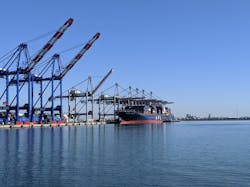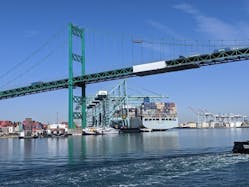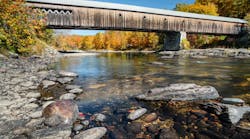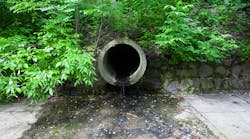Marine ports are unique environments where, due to heavy industrial uses and high-water tables, new or re-development projects are often unable to employ the Low Impact Development (LID) Best Management Practices (BMPs) required to meet stormwater management standards. Implementing stormwater capture, infiltration or reuse, and other treatment strategies to meet stormwater permit requirements is challenging and costly at port locations due to hydrology and operational constraints. Additionally, a high number of port industrial tenants have additional challenges implementing capture and treat BMPs to comply with industrial National Pollutant Discharge Elimination System (NPDES) permits. These challenges have led some port agencies to evaluate alternative compliance options for stormwater management.
Off-site alternative compliance is not a new idea. Alternative compliance can refer to a variety of stormwater management approaches, including installation of off-site LID projects and BMPs, water quality trading or banking, and in-lieu fee programs. The concept has been in use nationally since 1983 when the US Fish and Wildlife Service helped to establish the first wetland mitigation banks. Similarly, off-site projects can be used to improve overall water quality. The US Environmental Protection Agency (EPA) adopted a policy on water quality trading in 2003 as a way to address water quality issues and funding alternatives. EPA and state regulatory agencies have generally been supportive of off-site and regional stormwater management solutions where LID is not feasible. However, non-governmental environmental organizations (NGOs) have historically pushed for source control over stormwater treatment, which has inhibited many agencies from pursuing these alternatives.
A key driver for the development of off-site mitigation banking programs is the ability of regional BMP projects to provide greater water quality benefit to the overall watershed. Ports are generally a small percentage of overall watershed loading based on area. However, because ports are at the base of a watershed, the trade-off means that some Port loading may still occur. Off-site mitigation banking programs can provide greenhouse gas reduction, recreation opportunities, creation of open space, wildlife habitat creation and enhancement, water supply replenishment, or flood control by facilitating regional multi-benefit stormwater projects.
A review of existing off-site mitigation banking and alternative compliance guidance shows that the development of programs and participation in regional or watershed-based projects may provide ports pathways to both improve receiving water quality and meet stormwater permit requirements.
Regulatory Drivers
Developing an off-site mitigation banking program largely depends on local and federal regulatory acceptance. Regulatory provisions that consider these kinds of programs are described below.
California Stormwater Permit Requirements for LID
Stormwater permits may allow for various methods of alternative compliance in cases where on-site retention of the stormwater quality design volume is technically infeasible, even after other BMPs have been implemented to the maximum extent practical. Options for achieving compliance through alternative means include off-site infiltration, discharge to sanitary sewer and recycling, regional groundwater replenishment, and off-site retrofit of existing developments. Generally, regional projects should be constructed in the same sub-watershed as the new development or redevelopment projects that could not implement on-site controls. Areas outside of the sub-watershed but within the greater watershed can potentially be considered for off-site BMPs, but only if there are no opportunities within the local sub-watershed and greater water quality improvement can be achieved.
California Industrial General Permit
The Industrial General Permit (IGP) authorizes discharges of industrial stormwater to Waters of the United States that comply with all permit requirements it specifies a pathway of tiered actions as industrial stormwater dischargers work through reducing their impact on water quality. Port industrial facilities may be required to evaluate the need for constructed BMPs to prevent exceedances, estimate the cost of the BMPs, and provide an analysis describing the basis for selections of BMPs. A permittee’s participation in a mitigation bank program may allow them to achieve a water quality improvement in the greater receiving water and comply with the IGP through off-site mitigation when on-site BMPs are technically, economically, or physically infeasible.
Program Development Guidance
Existing off-site mitigation and in-lieu fee programs nationwide can provide guidance for the development of similar programs tailored for ports.
US Environmental Protection Agency Region 9
The EPA Region 9 has advocated with state agencies to allow off-site alternative compliance, even if on-site compliance may be feasible, in cases where a stormwater infiltration project may provide a greater beneficial impact in an alternate location. In April 2018, EPA Region 9 staff prepared the Off-Site Stormwater Crediting: Lessons from Wetland Mitigation paper. It identifies lessons from the history of wetland mitigation implementation, assesses existing case studies for off-site stormwater crediting, and summarizes recommendations for the development of a successful stormwater crediting program through robust permit provisions and effective, clear implementation at the local level.
The paper concludes that the specifics of any crediting program must be based on local conditions, but that a clear, specific definition of program structure and procedures will be critical to any program’s success. EPA Region 9 recommends, at a minimum, that stormwater permits should clearly authorize off-site stormwater compliance options and provide key components for program development that local governments should address when pursuing stormwater quality credit programs. Crediting and in-lieu fee program elements may include but are not limited to:
- Establishing legal authorities
- Authorizing crediting, fee collections, and fund allocation through local ordinances
- Maintaining a tracking registry for credit generation and use
- Creating an inventory of approvable projects to facilitate timely implementation
- Including inspection and enforcement provisions for credit certification in an Operations and Maintenance Agreement
California Central Coast Regional Water Quality Control Board (RWQCB): In-Lieu Fee Programs
The Central Coast RWQCB, LID Initiative, and the City of Watsonville, CA, supported a planning-level case study conducted to evaluate the feasibility of alternative compliance. Municipalities often desire flexibility in obtaining compliance, which supports the creation of a mechanism where project applicants can pay fees to a city to fund regional projects for stormwater controls within the same watershed.
The study concluded that in-lieu fee programs represent the best approach to alternative compliance programs in order to balance the risks and benefits of off-site compliance. Various “currency” can be used for in-lieu fee programs, but the recommended funding mechanism presented uses a reduction in runoff volume as the trading currency. Lessons learned in this case study may be helpful to other municipalities, particularly those with similar design storm requirements, low infiltration soils, or those considering flat rate in-lieu fee programs for alternative compliance.
Willamette Partnership: Water Quality Trading
Water quality trading is a market-based approach to improve and protect water quality. Trading programs can provide greater efficiency in achieving water quality goals by allowing emitters with high costs of compliance to use pollutant reductions created by another source with lower corresponding compliance costs. The Willamette Partnership (Partnership), in Portland, OR, was founded as a non-profit coalition of conservation, city, business, farm, and scientific leaders in 2004 to develop “innovative, market-based tools to deliver broad conservation benefits at lower costs and with reduced conflict.”
In June 2015, the Partnership, in conjunction with the World Resources Institute, prepared a report entitled Building a Water Quality Trading Program: Options and Considerations. This document is a product of the National Network on Water Quality Trading (National Network), which was established in 2013 and consists of 18 contributing organizations that represent farmers, wastewater and stormwater utilities, environmental groups, regulatory agencies, and other trading program stakeholders, including the Partnership. It discusses the key elements that many trading programs must consider during design of a program and focuses on trades where permitted wastewater and stormwater facilities purchase water quality benefits from nonpoint sources, typically agriculture, that are capable of reducing pollution to a greater extent than is required. Examples, as well as pros and cons, are included in order to assist stakeholders in building the best program to meet local needs and requirements. A set of guiding principles and elements common to many existing trading programs are identified that should be considered when designing and implementing new water quality trading programs.
Recommendations
There is a great deal of work being done nationwide to remove barriers to off-site alternative compliance programs. While existing guidance does not provide a prescriptive process for developing a water quality “bank,” many of the challenges that have been examined have some applicability for ports. Particularly, an in-lieu fee program structured for a port may provide a mechanism to assist with regional projects, while maintaining water quality compliance within a harbor district. Water quality trading should be encouraged to support water quality improvements where needed, but not otherwise possible without a funding mechanism. For example, economically disadvantaged communities with high pollutant loads upstream could benefit from trading with higher income areas downstream that cannot feasibly implement BMPs.
Based on available guidance, there is potential for ports to develop off-site mitigation programs with input from local regulators and watershed stakeholders. The implementation of off-site mitigation banking programs requires the establishment of a credit system so that stakeholders have a clear understanding of how costs are allocated. One potential unit of water quality “currency” could be the use of stormwater runoff volume reductions achieved by off-site BMPs. In California, runoff volume reduction is already accepted as a way to evaluate pollutant load reductions for meeting water quality-based effluent limits and receiving water limitations.
At present, there is currently no widely accepted metric for establishing the costs associated with the mitigation of industrial stormwater discharges. Costs are typically estimated on a case-by-case basis. For the purposes of developing a method for calculating the appropriate level of credit for any off-site mitigation project to which a port or tenant contributes, it will be necessary to look at available local resources on the cost of BMP implementation on a per-acre basis. Regulatory agencies typically analyze the cost of compliance in the development of new permits and other regulatory programs, such as Total Maximum Daily Loads. Utilizing existing cost estimates that are already approved by local regulatory agencies will help to establish the validity of the water quality credit value in an off-site mitigation banking program. As the potential cost of credits can vary widely based on the limited information currently available, ports should work with regulatory and other watershed stakeholders, to devise a credit value representative of the cost to achieve desired water quality improvements.
Jacqueline McMillen is a water resources project manager/senior consultant with NV5. She is a Registered Professional Civil Engineer and Qualified Industrial Stormwater Practitioner Trainer of Record (QISP/ToR) with 13 years of experience supporting industrial and municipal clients with their environmental compliance programs.
References
Parrish, Janet. Off-Site Stormwater Crediting: Lessons from Wetland Mitigation. US Environmental Protection Agency, Region 9. April 2018. www.epa.gov/sites/production/files/2018-10/documents/off-site_stormwater_crediting_lessons_from_wetland_mitigation-2018-04.pdf
Willamette Partnership, World Resources Institute, and the National Network on Water Quality Trading. Building a Water Quality Trading Program: Options and Considerations. June 2015. https://files.wri.org/s3fs-public/buiding-a-water-quality-trading-program-nn-wqt.pdf







